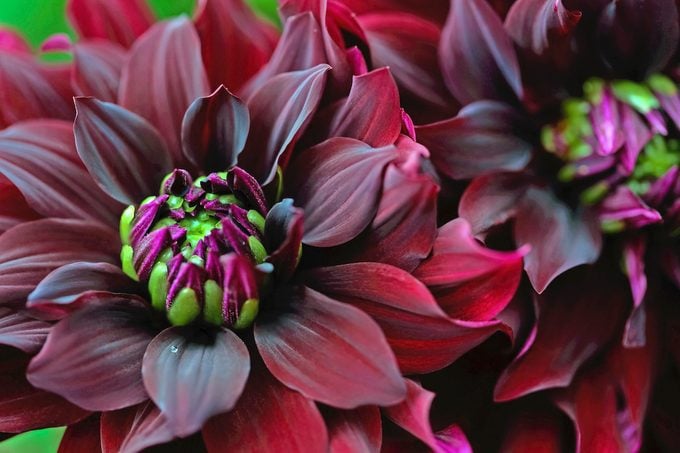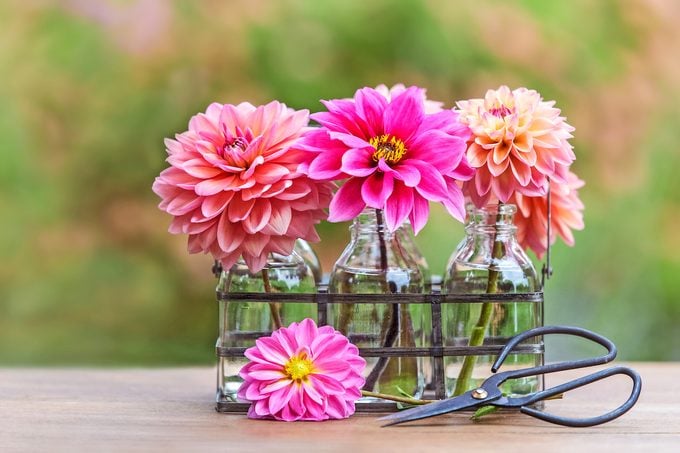Everything You Need to Know About Planting and Growing Dahlias
Updated: Jul. 16, 2024
With a little know-how, growing dahlias is an easy way to bring oodles of color to your flower garden.

Dahlias rank among the most delightful of garden surprises. A brown potato-like tuber erupts into a flower factory on a stalk, staging a months-long bloom show.
“Dahlias give you a larger variety of shapes, sizes and colors than other types of flowers,” says Nicholas Gitts, whose family owns Swan Island Dahlias in Canby, Oregon. Swan Island is the largest dahlia grower in the United States. “Dahlias also give you armloads of flowers over their blooming time—from late July through frost for most climates.”
Choose from lofty dahlias standing 5 feet or taller, or downsize with 12-inch dwarf types. Flower head sizes range from a dainty 2 inches across to the dinnerplate blooms that are nearly a foot wide. The flowers come with their own classifications, too: ball, pompon, cactus, anemone, collarette, single, peony, orchid, waterlily and dinnerplate, to name a few. You’ll find shades of red, yellow, white, bronze, purple and more. Some even have desirable dark foliage.
Check out gorgeous new dahlias gardeners will love.
Are Dahlias Perennials?
Despite fabulous attributes, dahlias seem daunting. “I think the number one reason people don’t grow dahlias is they think they have to dig and store the tubers at the end of the growing season,” Nicholas says.
Digging and storing is not complicated, but the easiest way to skip the step is to simply treat dahlias as annuals, leaving the tubers in the ground in cold climates to decompose. In Zones 8 or warmer, they are perennials. Just add winter cover and keep them in the ground.
Psst—this is the difference between annuals and perennials.
“Shorter-to-medium-height, early blooming dahlias are perfect plants for beginners,” Nicholas says, “because they provide quick results with less staking.” His suggestions include Jitterbug, a 3-foot dahlia with salmon petals and yellow highlights on a 2-inch bloom, and Touche, a 3-foot-tall plant with strong stems and 4-inch salmon-and-lavender semi-cactus blossoms.
Learn how to overwinter dahlias.
How to Grow Dahlias
For success, plant dahlias after all threat of frost has passed in regular garden soil that gets at least 8 hours of direct sun per day. Stake dahlias that grow taller than 3 feet using rods, cages or whatever you have on hand. Water deeply three times a week, depending on your soil. “They love lots of deep water during the growing season,” Nicholas says. Avoid high nitrogen fertilizers, and choose one where the first number (indicating nitrogen) is half the other two numbers listed. Apply once a month.
It may seem cruel, but you will get shorter, bushier plants with better stems by pinching or cutting the center shoot just above the third set of leaves or when dahlias reach 18 to 20 inches tall.
The most common dahlia pests include slugs, snails, earwigs, cucumber beetles, spider mites and mildew. Combat them by choosing any product that’s safe enough to use on vegetable plants.

Add Dahlias to Bouquets
For arrangements, it’s best to cut stems of fully opened flowers in the cool of the morning, but you can snip them any time. Nicholas recommends placing cut stems into 2 to 3 inches of very hot (160 to 180 degrees) water in a metal container and then letting the stems and water cool for an hour. “This will set your blooms and make your flowers last for four to six days,” he says. Change the water in the vase daily, and use a flower preservative to promote longevity.
Even when not cutting blooms for bouquets, snipping the stems of dahlias produces more flowers and a fuller plant. Remove any browning flower heads to promote rebloom.
It’s easy to design with dahlias. Just plant them anywhere you’d like a punch of color. “Check the height of the dahlia you’re going to plant to determine if you should plant it in the front or the back of your landscape beds,” Nicholas advises, and enjoy the splashes of color though the first frost.
Discover our top 10 favorite flowers for a cutting garden.




















